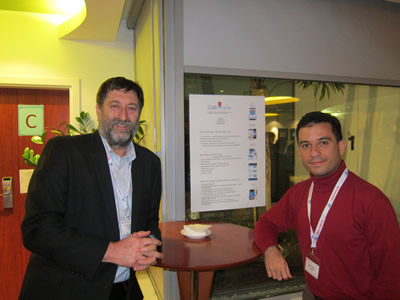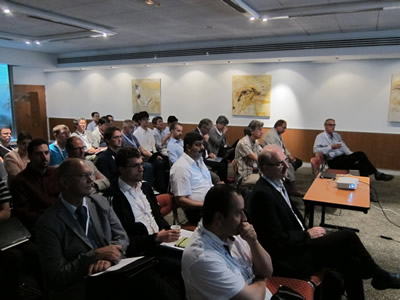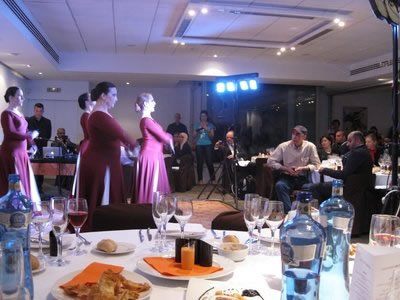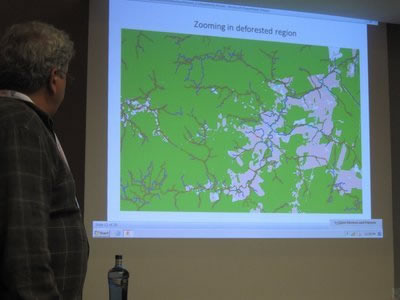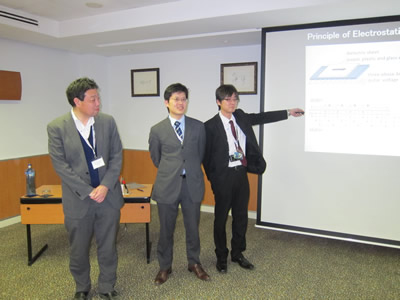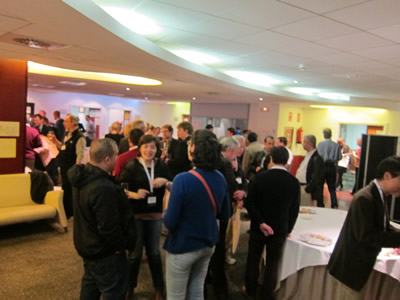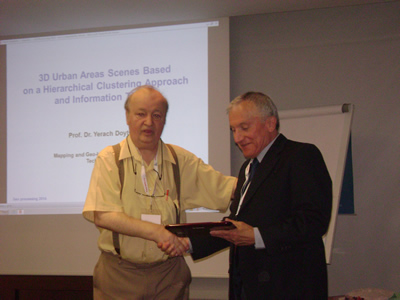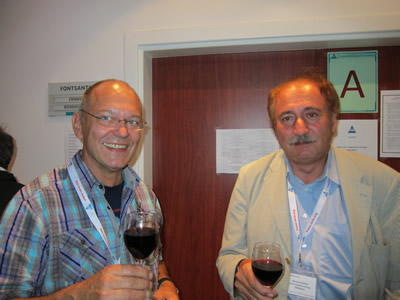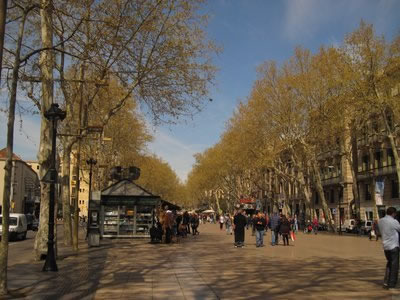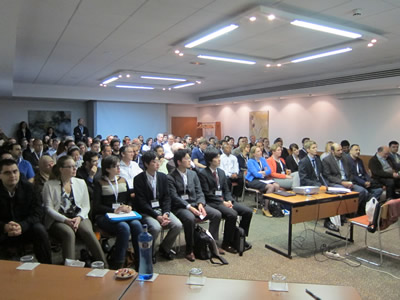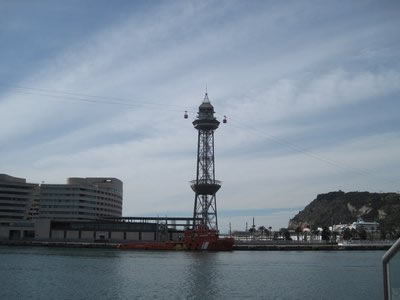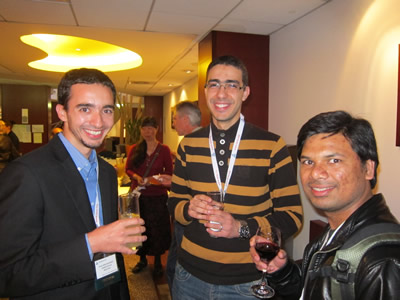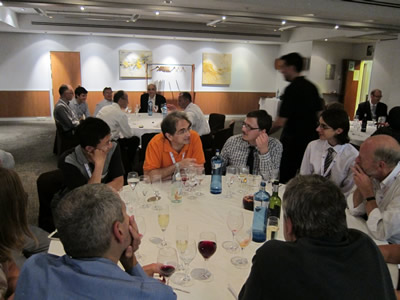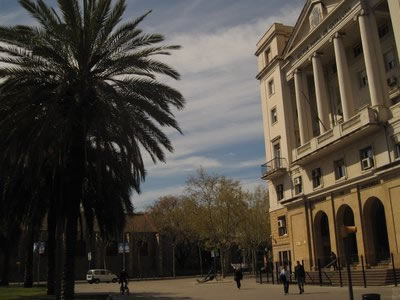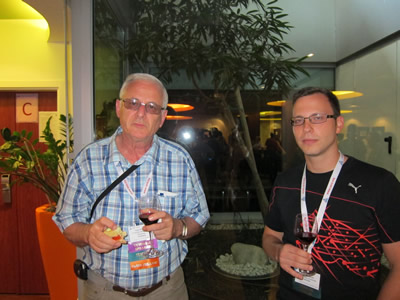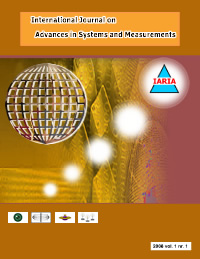SIGNAL 2023 - The Eighth International Conference on Advances in Signal, Image and Video Processing
March 13, 2023 - March 17, 2023
SIGNAL 2023: Call for Papers
Onsite and Online Options: To accommodate a large number of situations, we are offering the option for either physical presence or virtual participation (pdf slides or pre-recorded videos).
Signal, video and image processing constitutes the basis of communications systems. With the proliferation of portable/implantable devices, embedded signal processing became widely used, despite that most of the common users are not aware of this issue, New signal, image and video processing algorithms and methods, in the context of a growing-wide range of domains (communications, medicine, finance, education, etc.) have been proposed, developed and deployed. Moreover, since the implementation platforms experience an exponential growth in terms of their performance, many signal processing techniques are reconsidered and adapted in the framework of new applications.
SIGNAL 2023, The Seventh International Conference on Advances in Signal, Image and Video Processing, continues the inaugural event considering the challenges mentioned above. Having these motivations in mind, the goal of this conference is to bring together researchers and industry and form a forum for fruitful discussions, networking, and ideas.
We solicit both academic, research, and industrial contributions. We welcome technical papers presenting research and practical results, position papers addressing the pros and cons of specific proposals, such as those being discussed in the standard fora or in industry consortia, survey papers addressing the key problems and solutions on any of the above topics short papers on work in progress, and panel proposals.
Industrial presentations are not subject to the format and content constraints of regular submissions. We expect short and long presentations that express industrial position and status.
Tutorials on specific related topics and panels on challenging areas are encouraged.
The topics suggested by the conference can be discussed in term of concepts, state of the art, research, standards, implementations, running experiments, applications, and industrial case studies. Authors are invited to submit complete unpublished papers, which are not under review in any other conference or journal in the following, but not limited to, topic areas.
All topics and submission formats are open to both research and industry contributions.
SIGNAL 2023 conference tracks:
Architectures and frameworks
Signal processing architectures; Hardware and software for signal, image and video processing; Biosignal acquisition, transmission, processing, and analysis; Compressive sensing (sparse sampling); Deep learning (graphical inference algorithms); High speed video acquisition, architecture and processing; Real-time signal architectures for image and video processing; Distributed Iinformation processing, transmission and storage over networks; High speed signal processing and architectures; Big Iimage processing and analytics in multimedia tools and applications;
Signal processing theory and methods
Embedded signal processing; Signal and information processing on graphs; Audio and acoustic signal processing; Digital and multirate signal processing; Image and video processing; Multi-camera imaging; Speech and language processing; Multimedia signal processing; Signal processing for communications; Statistical signal processing; Sensor array and multi-channel signal processing; Machine learning, feature detections, bio-inspired techniques; Pattern recognition; Social learning models, Bayesian signal processing; Cognitive information processing; Biometric analysis, forensic analysis watermarking and security; Processing signal, image and video collections; Implementation of signal, image and video processing systems
High speed signal processing: integrating 5G and IoT with satellite networks
mmWave communications; Very high speed camera; High speed flying sensors; 6G - integrating 5G with satellite networks; Ultra-fast access signal processing; Satellite-to-satellite communications; Sea-to-space communications; Point-to-point wireless communication networks; Super-fast broadband signals; High speed optical broadcasting fibers lines; High data rates; Ultra fast access of Internet; Full home automation and home applications; Smart homes and cities; Global energy sources; Space and defense 6G-oriented technologies; Integrated satellite-to-satellite communications; Monitoring/driving natural calamities; Sea-to-Space communications; Nano antennas; Point-to-point wireless communication networks; Space roaming; Earth observation (backhaul link); Space observation (backhaul link); Small cells (cover zones without Internet); Space-IoT (monitoring sensors); Standard adaptation to 6G for handoff and roaming challenges (GPS, Galileo, COMPASS, GLONASS)
Agricultural signal applications
Agriculture systems; Sensing and monitoring ecological agriculture; Food security (Food safety, Traceability, Food value chain); Bioinformatics (Agricultural data, Livestock genetics, Big Data, etc.); Bio-sensing (Soil, Atmosphere, Culture monitoring, Livestock environment); Plasma, Micro Nano Bubble application to Agriculture; Field robotics (Drones, Field labor robotics, Robots-driven livestock care)
Signal/image metrics
Aesthetic quality assessment; Visual aesthetic; Image quality assessment; Blind noise assessment; Perceptual evaluation; Automatic segmentation; Perceptual video compression; Perceptual transparency; Energy-based segmentation; Ultrasound image segmentation; Photon-limited imaging; Processing demosaiced images; Image restauration; Image colorization; Image denoising; Image deconvolution; Random sampling; Semantic segmentation; Sparse imaging; Dense image arrays; Distortion visibility; Depth upsampling; Infrared, multispectral and hyperspectral imaging; Image inpainting; Patch matching; Image Stitching;
Features and models for images/signals
3D Quality assessment models; Adaptive smoothing; Background subtraction; Probabilistic illumination models; Cumulative orientation features;
Efficient video saliency; Deep convolutional networks; Edge-aware filters; Prediction inaccuracy modeling; Temporal predictions; Interactive multiview videos; Video authentication; Multi-modal images; Image mosaicking; Image fusion; Low-contrast images; Adaptive pixel transfer; Omnidirectional imaging; Superpixels and adaptive superpixels; Unsupervised segmentation; Edge detection; Morphological profiles
Image/signal computation and services
Computational imaging; Biological imaging; Visual saliency; Computational photography; Perceptual metrics; 3D Data analysis; Visual content analysis; Video retrieval; Videoconfences; Healthcare exercising signals; 3D Virtual views; Measuring seismic images; Landmark detection; Aerial images; Motion recognition; Object tracking; Crowd scenes; Satellite images; Visual media compression; Adaptive quantization; SDN for videos; Scene analysis; Scene recognition; Anomaly detection; High quality streaming media; Detecting urban roads; Action recognition; Lenses; Plenoptic cameras; Curvature detection; Normalized cuts and geodesics;
Special signal, image and video processing applications/domains
Big data collection, retrieval, analysis; Cyber-physical systems; Energy and smart Grid; Monitoring and control systems; Wireless and Internet of Things; Sensors and Body networks; Healthcare and citizen wellbeing; Transportation systems; 5G communications Networks and mm-Wave Systems; Cognitive radio networks; Cyber-physical security; Social networks and finance applications, etc.
Hands-free speech communication and microphone arrays
Acoustic scene analysis; Acoustic event detection; Dereverberation; Echo cancellation; Noise suppression; Hearing aids; Microphone array technology and architectures; Source localization and separation; Spatial audio for immersive environments; Speech acquisition; Speech and speaker recognition technology; Speech and audio quality assessment; Privacy of speech communications, etc.
Wearable sensor signal processing
Signal pre-processing algorithms; Physiological parameter monitoring; Noise reduction; Feature extraction and classification; Off-line bio-signal processing; Real-time processing of sensor signals; Bio-mechanical feedback for diagnosis and rehabilitation; Static and dynamic calibration; Signal processing to improve sensor precision and accuracy; Time-efficient and power-efficient algorithms for big data; Sensor data fusion and integration; Body-area sensor networks: real-time communication and synchronization; Gesture and movement pattern recognition; Motion/Gait tracking, recognition, and analysis; Motion segmentation and evaluation; Wearable prototypes in human-centric experiments, etc.
Deadlines:
Submission | Dec 15, 2022 |
Notification | Jan 23, 2023 |
Registration | Feb 05, 2023 |
Camera ready | Feb 15, 2023 |
Deadlines differ for special tracks. Please consult the conference home page for special tracks Call for Papers (if any).
INSTRUCTION FOR THE AUTHORS
Authors of selected papers will be invited to submit extended versions to one of the IARIA Journals.
Publisher: XPS (Xpert Publishing Services)
Archived: ThinkMindTM Digital Library (free access)
Prints available at Curran Associates, Inc.
How to submit to appropriate indexes.
Only .pdf or .doc files will be accepted for paper submission. All received submissions will be acknowledged via an automated system.
Contribution types
- regular papers [in the proceedings, digital library]
- short papers (work in progress) [in the proceedings, digital library]
- ideas: two pages [in the proceedings, digital library]
- extended abstracts: two pages [in the proceedings, digital library]
- posters: two pages [in the proceedings, digital library]
- posters: slide only [slide-deck posted on www.iaria.org]
- presentations: slide only [slide-deck posted on www.iaria.org]
- demos: two pages [posted on www.iaria.org]
FORMATS
Only .pdf or .doc files will be accepted for paper submission. All received submissions will be acknowledged via an automated system.
Final author manuscripts will be 8.5" x 11", not exceeding 6 pages; max 4 extra pages allowed at additional cost.
Helpful information for paper formatting for MS Word can be found here.
There is a community provided LaTeX template: the CTAN package iaria (with full IARIA formatting rules, including IARIA citation style, but for providing citation style it is tightly bound to pdflatex+biblatex+biber). In addition, there is also iaria-lite (not bound to pdflatex+biblatex+biber, but compatible with any TeX stack; thus, it cannot provide the IARIA citation formattings, but only the titlepage and content-related IARIA formatting rules). Based on the iaria package, there is a minimal working example as Overleaf template. When you are using the LaTeX templates, please still adhere to the additional editorial rules.
Slides-based contributions can use the corporate/university format and style.
Your paper should also comply with the additional editorial rules.
Once you receive the notification of contribution acceptance, you will be provided by the publisher an online author kit with all the steps an author needs to follow to submit the final version. The author kits URL will be included in the letter of acceptance.
We would recommend that you should not use too many extra pages, even if you can afford the extra fees. No more than 2 contributions per event are recommended, as each contribution must be separately registered and paid for. At least one author of each accepted paper must register to ensure that the paper will be included in the conference proceedings and in the digital library, or posted on the www.iaria.org (for slide-based contributions).
CONTRIBUTION TYPE
Regular Papers (up to 6-10 page article -6 pages covered the by regular registration; max 4 extra pages allowed at additional cost- ) (oral presentation)
These contributions could be academic or industrial research, survey, white, implementation-oriented, architecture-oriented, white papers, etc. They will be included in the proceedings, posted in the free-access ThinkMind digital library and sent for indexing. Please submit the contributions following the instructions for the regular submissions using the "Submit a Paper" button and selecting the appropriate contribution type. 12-14 presentation slides are suggested.
Short papers (work in progress) (up to 4 pages long) (oral presentation)
Work-in-progress contributions are welcome. These contributions represent partial achievements of longer-term projects. They could be academic or industrial research, survey, white, implementation-oriented, architecture-oriented, white papers, etc. Please submit the contributions following the instructions for the regular submissions using the "Submit a Paper" button and selecting the contribution type as work in progress. Contributors must follow the conference deadlines, describing early research and novel skeleton ideas in the areas of the conference topics. The work will be published in the conference proceedings, posted in the free-access ThinkMind digital library and sent for indexing. For more details, see the Work in Progress explanation page. 12-14 presentation slides are suggested.
Ideas contributions (2 pages long) (oral presentation)
This category is dedicated to new ideas in their very early stage. Idea contributions are expression of yet to be developed approaches, with pros/cons, not yet consolidated. Ideas contributions are intended for a debate and audience feedback. Please submit the contributions following the instructions for the regular submissions using the "Submit a Paper" button and selecting the contribution type as Idea. Contributors must follow the conference deadlines, describing early research and novel skeleton ideas in the areas of the conference topics. The work will be published in the conference proceedings, posted in the free-access ThinkMind digital library and sent for indexing. For more details, see the Ideas explanation page. 12-14 presentation slides are suggested.
Extended abstracts (2 pages long) (oral presentation)
Extended abstracts summarize a long potential publication with noticeable results. It is intended for sharing yet to be written, or further on intended for a journal publication. Please submit the contributions following the instructions for the regular submissions using the "Submit a Paper" button and selecting the contribution type as Extended abstract. Contributors must follow the conference deadlines, describing early research and novel skeleton ideas in the areas of the conference topics. The work will be published in the conference proceedings, posted in the free-access ThinkMind digital library and sent for indexing. 12-14 presentation slides are suggested.
Posters (paper-based, two pages long) (oral presentation)
Posters are intended for ongoing research projects, concrete realizations, or industrial applications/projects presentations. The poster may be presented during sessions reserved for posters, or mixed with presentation of articles of similar topic. A two-page paper summarizes a presentation intended to be a POSTER. This allows an author to summarize a series of results and expose them via a big number of figures, graphics and tables. Please submit the contributions following the instructions for the regular submissions using the "Submit a Paper" button and selecting the contribution type as Poster Two Pages. Contributors must follow the conference deadlines, describing early research and novel skeleton ideas in the areas of the conference topics. The work will be published in the conference proceedings, posted in the free-access ThinkMind digital library and sent for indexing. 8-10 presentation slides are suggested. Also a big Poster is suitable, used for live discussions with the attendees, in addition to the oral presentation.
Posters (slide-based, only) (oral presentation)
Posters are intended for ongoing research projects, concrete realizations, or industrial applications/projects presentations. The poster may be presented during sessions reserved for posters, or mixed with presentation of articles of similar topic. The slides must have comprehensive comments. This type of contribution only requires a 8-10 slide-deck. Please submit the contributions following the instructions for the regular submissions using the "Submit a Paper" button and selecting the contribution type as Poster (slide-only). The slide-deck will be posted, post-event, on www.iaria.org.
8-10 presentation slides are suggested. Also a big Poster is suitable, used for live discussions with the attendees, additionally to the oral presentation.
Presentations (slide-based, only) (oral presentation)
These contributions represent technical marketing/industrial/business/positioning presentations. This type of contribution only requires a 12-14 slide-deck. Please submit the contributions following the submission instructions by using the "Submit a Paper" button and selecting the contribution type as Presentation (slide-only). The slide-deck will be posted, post-event, on www.iaria.org.
12-14 presentation slides are suggested.
Demos (two pages) [posted on www.iaria.org]
Demos represent special contributions where a tool, an implementation of an application, or a freshly implemented system is presented in its alfa/beta version. It might also be intended for thsoe new application to gather the attendee opinion. A two-page summary for a demo is intended to be. It would be scheduled in special time spots, to ensure a maximum attendance from the participants. Please submit the contributions following the submission instructions by using the "Submit a Paper" button and selecting the contribution type as Demos. The Demos paper will be posted, post-event, on www.iaria.org.
Tutorial proposals
Tutorials provide overviews of current high interest topics. Proposals should be for 2-3 hour long. Proposals must contain the title, the summary of the content, and the biography of the presenter(s). The tutorial slide decks will be posted on the IARIA site.
Please send your proposals to tutorial proposal
Panel proposals
The organizers encourage scientists and industry leaders to organize dedicated panels dealing with controversial and challenging topics and paradigms. Panel moderators are asked to identify their guests and manage that their appropriate talk supports timely reach our deadlines. Moderators must specifically submit an official proposal, indicating their background, panelist names, their affiliation, the topic of the panel, as well as short biographies. The panel slide deck will be posted on the IARIA site.
Please send your proposals to panel proposal


